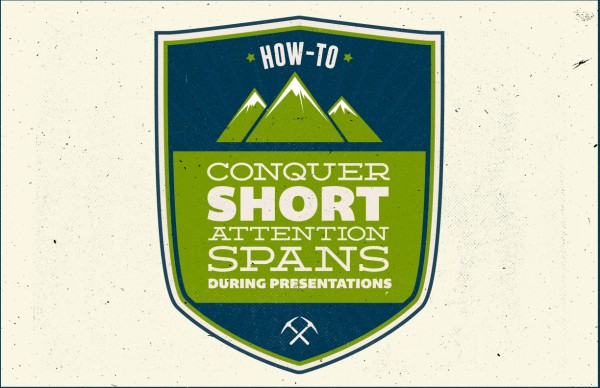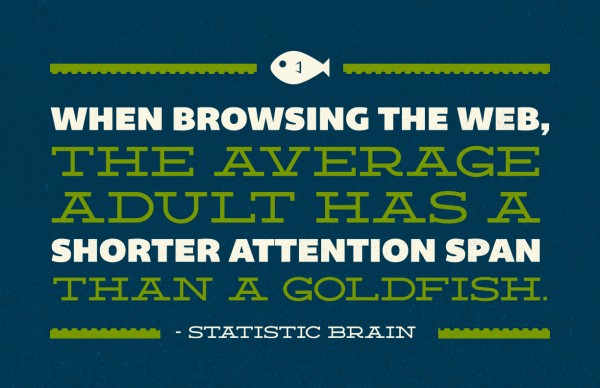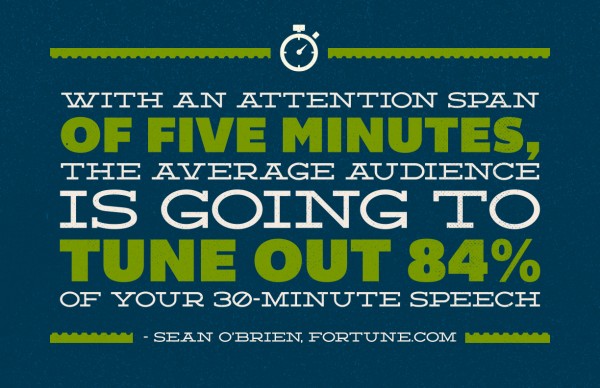Being compared to a goldfish is not a good thing. Goldfish are given away in plastic bags in exchange for pocket change at fairs. If your new pet goldfish dies, most people would suggest flushing it down the toilet, or tossing it in the trash. Kinda sad, huh? The story gets even sadder when you consider that in some situations the human mind is inferior to the mind of a common goldfish, at least in regards to attention span.
Despite occasional inferiority to a goldfish, the human brain is a powerful organ capable of completing complex tasks that require enormous amounts of focus. Thus, if your presentation does not inspire your audience to stretch their attention spans beyond the limits of a small fish, it is your fault. Don’t place blame on modern lifestyle habits, or technology. Take responsibility for keeping the audience engaged during your presentation. Use these 5 tips to connect with your audience members, and expand their attention spans to the length of your talk.

1. Start strong.
In the study, Not Quite the Average: An Empirical Study of Web Use, researchers determined that the average human span in 2013 was only 8 seconds (the average goldfish can pay attention for 9 seconds). As you can tell by the title of the study, researchers tested the human attention span specifically for web browsing. If you are designing your presentation to share on SlideShare, or other online platforms, you must communicate a compelling message in the first 8 seconds of your presentation, or risk losing your audience.

The 8 second rule can also be valuable for presentations that take place in the real world (as opposed to the Internet). Since everyone has the Internet in their pocket at all times, it is safe to assume that audience members will stop listening to your presentation after 8 dull seconds, and instead scroll through social media, or answer emails, if possible.
To hook viewers within the first 8 seconds, use sophisticated design techniques to create slides that are aesthetically pleasing and interesting to view. Also, carefully craft a title that will resonate with your target audience. If you can use your title to point to the problem that your content will solve for your audience, your odds of gaining and keeping attention will increase dramatically.
The first slides following your title slide should be dynamic in style and content. Don’t save your best ideas until the end of the presentation. From the start, convince your audience that your presentation is worth their time
2. Mix it up.
If your audience is still paying attention after the first 8 seconds, you have approximately 4 minutes and 52 seconds until their attention spans are exhausted. The average adult attention span has plummeted from 12 minutes a decade ago to just 5 minutes now, according to a Fortune.com article.

If you can deliver your entire presentation in a total of 5 minutes or less, go for it; your audience will love you.
For everyone else, break your presentation into a series of 5 minute experiences, separated by small breaks. To create a break, you can simply take a breath or two to give the audience a moment of silence before launching into the next section. For longer presentations, or presentations on complex topics, consider giving your audience enough time to stretch their legs and get some fresh air. If possible, limit your presentation to a total of 20 minutes, the maximum amount of time most audiences can actively listen to a presentation.
3. Solve a problem.
Instead of unloading information on audience members, lighten their loads by using your presentation to make their lives better. Craft your material so that your message directly speaks to the audience members. Give solutions, insights, inspiration, or even entertainment. Just don’t make your presentation all about you and your ideas.
Before you start writing and designing your presentation, research your audience. Identify a list of ways that your presentation can be custom built for the interests and needs of the audience. Select the most compelling connections between your audience and your message; use these connections as a compass to guide you as you create your presentation. When you deliver your presentation, use the pronoun you more than I.
Even if your ideas are brilliant, you still need to package your ideas in a presentation designed to serve as a resource for the audience; that is the best way to keep the attention on you.
4. Earn Respect.
“Seek respect, not attention. It lasts longer.” ― Ziad K. Abdelnour
Having the respect of your audience is one of the best techniques for getting and keeping attention during your presentation. To earn respect as a presenter, take the time to create an exceptional presentation with a meaningful message and stunning visuals.
To get started, do your homework. Review your topic from every angle. Schedule enough time to thoughtfully write and design your presentation. Seek feedback on your content and visuals. Edit. Seek more feedback. Edit again. Practice, and practice more.
The day of your presentation, arrive early to the presentation venue. While presenting, speak with confidence, make eye contact with audience members, and be mindful of your audience members’ needs, interests and most importantly, their time.
Take your presentation and your audience seriously, and you will be on the path to gaining respect, and holding attention for the duration of your presentation.
5. Lighten up.
Presentations are notorious for lulling people to sleep. No one will ever claim that they experienced Death By PowerPoint because they felt like dying due to excessive fun during a presentation. Thus, presenters have to rise above traditional presentation styles that bore people to tears to conquer the notoriously short attention span of the average adult. To save your audience from Death by PowerPoint, tell stories, use humor, be unexpected, and interact with the audience when possible. Never use bullet points. And if you are always serious during presentations, try to lighten up. Your audience will be energized by your positive attitude.
Conclusion: The average adult might lose interest easily, but is that really surprising? With seemingly endless options for entertainment and education, it should not be a shock to learn that people choose not to pay attention to things that don’t interest them. As a presenter, it is your responsibility to make your presentation a valuable, worthwhile experience for your audience. To be a successful presenter, start by following these 5 tips for conquering short attention spans during presentations.
